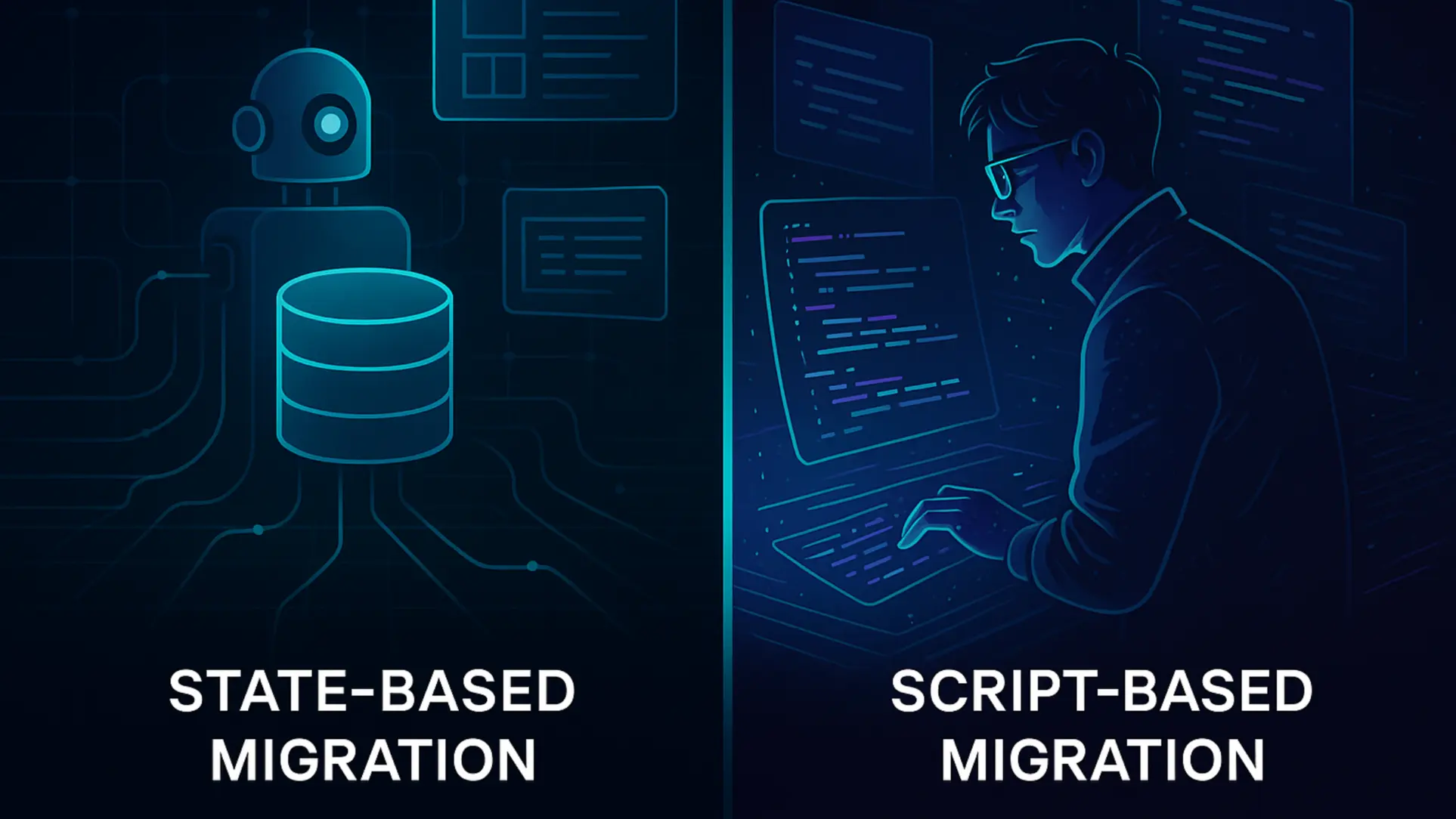
Modern CI/CD demands reliable, automated database changes - yet traditional state or script - only approaches fall short. Harness Database DevOps unifies both models, enabling teams to define schema declaratively while executing controlled, versioned scripts. This hybrid strategy accelerates deployments, ensures consistency, and integrates seamlessly with GitOps workflows.
The Legacy Bottleneck in Modern CI/CD
In today’s fast‑paced development cycles, database changes often become the bottleneck in CI/CD pipelines. We have databases that evolve alongside applications without agile tooling, schema drift, version mismatches, and deployment risks slow down releases.
When we ship a new feature, it’s not enough to deploy code, we must ensure the database schema (i.e. its data structure) matches expectations. Without precise versioning, you end up in the dreaded world of schema drift: where staging and production diverge, and unexpected failures surface.
Increasingly, teams are embracing Database DevOps, bringing CI/CD practices to data layers. But that raises a question: how should we manage schema migrations? Two common strategies dominate: state‑based migrations and script‑based migrations. Each has trade‑offs that shape release velocity, reliability, and automation.
Let’s explore them, and see how Harness Database DevOps helps combine the best of both worlds.
Defining the Concepts: State Migrations vs Script Migrations
What is a State‑based Migration?
In a state‑based approach, you define the desired end‑state of a database schema (tables, columns, etc.). A tool compares the current schema to the target state and auto‑generates the SQL needed to bridge the gap. It’s analogous to Kubernetes: declare what you want, and let the tool figure out how to get there. This simplicity empowers developers, no need to hand‑craft SQL for each change.
However, the simplicity comes with a catch: databases retain data and state. Two seemingly identical instances might differ in hidden ways. When you apply identical state definitions, generated scripts can vary, potentially causing data‑destructive operations in production, even if staging went well. That inconsistency is what has pushed organisations away from state‑only management.
What is a Script‑based Migration?
With script‑based migrations, every schema change is a discrete SQL script. These run in a specific sequence, tracked by tools that record which scripts have been executed.
The outcome? Deterministic, reproducible, and testable migrations. If it works in staging, you know it will run the same in production. Teams gain confidence and mitigate risk. But this requires SQL expertise. For example:
Developers need to write every ALTER or DROP statement manually. That can slow iteration, introduce errors, and demand significant DBA involvement. And each script must be carefully crafted and executed in sequence - increasing complexity as your application scales.
Challenges with Traditional Approaches
State-based tools simplify initial moves but lack repeatability and can cause destructive surprises. Script-based strategies offer control but require manual SQL skills and discipline. How can teams get the best of both simplicity in definition and safety in execution?
Introducing Harness Database DevOps
One of the biggest challenges in modern Database DevOps is choosing between ease and control. State-based migrations offer simplicity, while script-based migrations ensure predictability. But why choose one when you can have both?
Harness Database DevOps is purpose-built to unify these approaches. It brings GitOps workflows to your database layer, integrating seamlessly with Liquibase OSS to automate, validate, and version your schema changes. The result is a system that’s declarative at the developer level, but deterministic at runtime.
How It Bridges the Best of Both Worlds?
Harness Database DevOps reimagines schema management by combining the ease of declarative workflows with the safety of versioned execution. Harness extends Liquibase by enabling workflows that start from a state-based diff, then generate reproducible, versioned migration scripts for controlled execution.
This creates a hybrid model: declarative intent → deterministic implementation.
1. Define the Desired State : Developers describe intended schema changes using Liquibase changelogs or modify a development instance using SQL clients. This forms the starting point for capturing the schema delta.
2. Detect the Difference : Harness DB DevOps can run a pipeline to compare the current state of the development database with the schema defined in Git. It uses Liquibase's diff-changelog capability to generate a series of Liquibase changesets that represents the delta between the two.
3. Generate and Version the Script: The generated SQL script is committed to Git as a new versioned migration. This enforces a script-based model while still allowing developers to work declaratively.
4. Apply in CI/CD Pipelines: The migration script is applied using Harness pipelines across dev, staging, and production environments. This guarantees consistency and full visibility at every step.
5. Verify the Outcome: Harness DBOps allows you to define custom verification queries that run after deployment, ensuring the database behaves as expected post-migration.
6. Roll Back on Failure: If a verification step fails or the deployment encounters an issue, Harness automatically rolls back the migration using rollback logic defined in your Liquibase changelog. This prevents partial states and data loss.
Why This Model Is Effective?
By combining state-based authoring with script-based execution, Harness offers a balanced, scalable, and secure approach to managing schema changes:
.png)
Harness Database DevOps offers a straightforward, automated solution for modernizing database delivery and resolving persistent operational challenges. This cohesive workflow empowers teams to prioritize value delivery, eliminating concerns about deployment discrepancies or data integrity vulnerabilities.
The Future of Database DevOps is Declarative, Safe, and Automated
Modern Database DevOps isn’t about choosing one niche approach; it’s about a hybrid, declarative pipeline that is:
- Declarative: define the desired state once.
- Automated: generate scripts, perform migrations, run tests.
- Safe: predictable script execution, rollback, and governance.
- Visible: audit trails, diff comparisons, cross‑environment status.
- Integrated: treat databases as code alongside applications.
Conclusion
Database changes can't be an afterthought in modern software delivery. We need declarative, version‑controlled, automated, and safe mechanisms without sacrificing developer velocity.
- State‑based tools offer high-level simplicity but unpredictable, inconsistent outcomes.
- Script‑based migrations offer safety and repeatability but require manual overhead.
- Harness Database DevOps combines the best: define desired state with Liquibase OSS, generate script‑based migrations, and deploy them with automated testing and rollback.
The result? Reliable database deployments, accelerated CI/CD pipelines, and greater developer confidence, all while keeping data integrity front and center. If you're ready to move from chaotic database releases to a disciplined, secure, DevOps‑driven workflow, Harness Database DevOps is your bridge.
FAQs
1. Can I still write custom SQL?
Yes, Liquibase OSS supports raw SQL or formatted-changelog approaches for stored procs, functions, triggers, etc. If you need more control, include custom SQL using sqlFile changeTypes.
2. What if I use a state-only tool today?
You can start with your state definitions. Harness can auto-generate migrations based on diffs. The strategy remains code‑centric and safe; there is no need to rewrite your approach.
3. How do rollbacks work?
Harness executes rollback logic defined in each changeset. If any step fails, the system reverts all changes and notifies the team. Rollback scripts can be auto‑generated, versioned, and tested
4. Does this support GitOps?
Absolutely. Harness supports branch‑per‑environment or context‑based GitOps workflows. Migrations are tied to Git versions, and promotions occur via pull‑requests or pipeline triggers.

